Arto's Blog
| « Good bye bicycles, we'll go sailing! | Like a painted scenery » |
Road through the wilderness
Posted: 2015-02-27 19:15:00, Categories: Travel, Cycling, Chile, Argentina, 1258 words (permalink)
 After our hiking trip in National Reserve Cerro Castillo we continued
cycling south on the Carretera Austral. There were no cities or major
towns any more and even villages were further and further apart from
each other. Especially the last 200 km stretch from Cochrane until
Villa O'Higgins was a small road through the wilderness, with few
houses and plenty of moors between the mountains, rivers and forests.
After our hiking trip in National Reserve Cerro Castillo we continued
cycling south on the Carretera Austral. There were no cities or major
towns any more and even villages were further and further apart from
each other. Especially the last 200 km stretch from Cochrane until
Villa O'Higgins was a small road through the wilderness, with few
houses and plenty of moors between the mountains, rivers and forests.
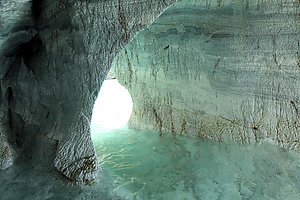 After Villa Cerro Castillo the pavement ended and the road headed
directly west for quite a while before turning south again. The next
slightly bigger settlement was Puerto Rio Tranquilo, a touristy town
famous for its marble cliffs and caves. Like most visitors, we took
a boat tour to see them. The boat spent more than half an hour near
the rock formations and went inside several of the caves, so we were
quite satisfied with the tour. The way back was like a roller
coaster ride, the small boat jumping up and down the waves on
the windy lake.
After Villa Cerro Castillo the pavement ended and the road headed
directly west for quite a while before turning south again. The next
slightly bigger settlement was Puerto Rio Tranquilo, a touristy town
famous for its marble cliffs and caves. Like most visitors, we took
a boat tour to see them. The boat spent more than half an hour near
the rock formations and went inside several of the caves, so we were
quite satisfied with the tour. The way back was like a roller
coaster ride, the small boat jumping up and down the waves on
the windy lake.
 The road followed the coast of the lake General Carrera, at times
high on top of the cliffs offering marvellous views of the lake. At
the bridge over the narrow passage between lake General Carrera and
lake Bertrand we stopped for a break. A Chilean family was enjoying
the sunny afternoon and the father started fishing using a simple
reel of line, a hook and baits. Within twenty minutes he had caught three
trouts, one weighing a bit less than a kilo and two smaller ones,
one of which he gave to us to cook for dinner.
The road followed the coast of the lake General Carrera, at times
high on top of the cliffs offering marvellous views of the lake. At
the bridge over the narrow passage between lake General Carrera and
lake Bertrand we stopped for a break. A Chilean family was enjoying
the sunny afternoon and the father started fishing using a simple
reel of line, a hook and baits. Within twenty minutes he had caught three
trouts, one weighing a bit less than a kilo and two smaller ones,
one of which he gave to us to cook for dinner.
 Following day we arrived to the southern end of lake Bertrand, where the
water was flowing out forming the beginning of the Baker river. It
was one of the most beautiful rivers on our route, with clear
blue water rushing down the valley. Some 15 kilometers
further south was the confluence of rivers Baker and Nef, where
large masses of water joined each other with great force. The water
from Nef was much more brown so Baker lost its superb colour at
that point.
Following day we arrived to the southern end of lake Bertrand, where the
water was flowing out forming the beginning of the Baker river. It
was one of the most beautiful rivers on our route, with clear
blue water rushing down the valley. Some 15 kilometers
further south was the confluence of rivers Baker and Nef, where
large masses of water joined each other with great force. The water
from Nef was much more brown so Baker lost its superb colour at
that point.
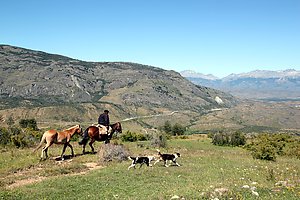 Before arriving to Cochrane, we took an alternative route on the
other side of the Baker river. In distance it was probably even a
bit shorter than the main road, but included a very steep climb of
500 meters of altitude over a pass. We had to push our bikes several times,
but enjoyed the views and the quietness of the route — during
the whole 30 km we saw only one car and a horseman.
Before arriving to Cochrane, we took an alternative route on the
other side of the Baker river. In distance it was probably even a
bit shorter than the main road, but included a very steep climb of
500 meters of altitude over a pass. We had to push our bikes several times,
but enjoyed the views and the quietness of the route — during
the whole 30 km we saw only one car and a horseman.
Cochrane was a slightly larger town than all others in the region with a couple of thousand inhabitants and a better than average selection of groceries. We bought food for a week knowing that there wouldn't be any shops during the next 230 kilometers, and headed out to the last section towards Villa O'Higgins, the southernmost point of the Carretera Austral.
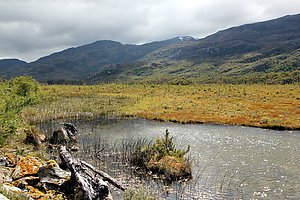 The first 40 kilometers after Cochrane was very bad gravel with a
lot of washboard, not the most enjoyable cycling experience. There
was also still a significant amount of traffic, mostly cars and
minivans heading to Caleta Tortel, a village famous of its wooden
walkways by the sea. We were not willing to cycle 25 km there and
the same way back to see the village so we skipped it and continued
directly south from the Tortel crossing.
The first 40 kilometers after Cochrane was very bad gravel with a
lot of washboard, not the most enjoyable cycling experience. There
was also still a significant amount of traffic, mostly cars and
minivans heading to Caleta Tortel, a village famous of its wooden
walkways by the sea. We were not willing to cycle 25 km there and
the same way back to see the village so we skipped it and continued
directly south from the Tortel crossing.
After the crossing of Caleta Tortel the number of cars reduced dramatically and the road became nicer and nicer. Water was flowing down from the mountains on both sides of the road in numerous small streams. There were many lakes and even more wetland, making us feel like being in Swedish or Norwegian Lapland. It was the only road through wilderness with only an occasional house every 10 or 20 kilometers, which contributed to the Lapland feeling. Although even here fences often separated the privately owned lands from the public road, there were plenty of wonderful places for wild camping.
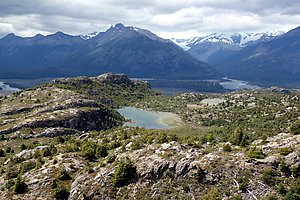 We came forwards a bit faster than we had anticipated and arrived in
4,5 days to Villa O'Higgins. It was a rather pleasant village or
small town, mostly living from the tourism but featuring modest
family-owned guesthouses and small grocery stores instead of hotels
and fancy restaurants. It was a dead end for everybody coming by a
motor vehicle, which meant that most didn't bother to drive that
far. There was a general sense of calmness and we heard of many people
who had stayed in the village longer than they had originally
planned. We spent three days resting and going for a couple of short
walks, and would have probably stayed for some days more if we
didn't have a certain date to be in Ushuaia, still quite a long way
further south.
We came forwards a bit faster than we had anticipated and arrived in
4,5 days to Villa O'Higgins. It was a rather pleasant village or
small town, mostly living from the tourism but featuring modest
family-owned guesthouses and small grocery stores instead of hotels
and fancy restaurants. It was a dead end for everybody coming by a
motor vehicle, which meant that most didn't bother to drive that
far. There was a general sense of calmness and we heard of many people
who had stayed in the village longer than they had originally
planned. We spent three days resting and going for a couple of short
walks, and would have probably stayed for some days more if we
didn't have a certain date to be in Ushuaia, still quite a long way
further south.
For cyclists and backpackers, it was possible to continue further from Villa O'Higgins and to cross the border to Argentina. Actually there were even two alternatives, a road and hike over the mountains to the east and a more well known ferry crossing plus hike towards the south. We chose the latter, mainly because it brought us much more directly towards Puerto Natales, where we had sent a package at the beginning of our trip to pick up later.
 One of the two ships crossing the lake O'Higgins offers a half day
side trip until the glacier carrying the same name. Compared to the
steep fare of simply getting on the other side of the lake, the
glacier tour was more reasonably priced so we decided to go for the
full package. The tour brought us close to the impressive wall of
ice several dozen meters high, with small icebergs breaking off and
floating on the lake. We had never been so close to a big
glacier before and with its various shades of blue it was more
colourful than other glaciers we had seen on the trip. As a small
surprise a glass of whisky with glacier ice was served to all
passengers. We opted for the kids' version of juice and ice,
adding alcohol to our already slightly upset stomachs after the
trip on the windy lake didn't feel like a good idea.
One of the two ships crossing the lake O'Higgins offers a half day
side trip until the glacier carrying the same name. Compared to the
steep fare of simply getting on the other side of the lake, the
glacier tour was more reasonably priced so we decided to go for the
full package. The tour brought us close to the impressive wall of
ice several dozen meters high, with small icebergs breaking off and
floating on the lake. We had never been so close to a big
glacier before and with its various shades of blue it was more
colourful than other glaciers we had seen on the trip. As a small
surprise a glass of whisky with glacier ice was served to all
passengers. We opted for the kids' version of juice and ice,
adding alcohol to our already slightly upset stomachs after the
trip on the windy lake didn't feel like a good idea.
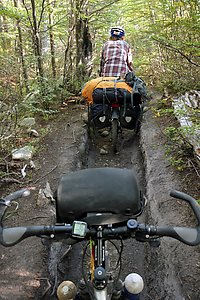 The majority of passengers returned on the ship to Villa O'Higgins,
we and a few others stepped out on the south side of the lake, where
we camped for a night before continuing. The Chilean border control
was only a few hundred meters further, the actual border with
Argentina 15 kilometers away. Until that point there was a narrow
gravel road, followed by a 6 km hiking trail leading to the Argentinian
border post at Lago Desierto. It was a scenic but pretty strenous
day, as our loaded bicycles were not the ideal vehicles for a narrow
trail going over roots and stones. However, we got through with lots
of time and patience, as all the other cyclists taking the same
route.
The majority of passengers returned on the ship to Villa O'Higgins,
we and a few others stepped out on the south side of the lake, where
we camped for a night before continuing. The Chilean border control
was only a few hundred meters further, the actual border with
Argentina 15 kilometers away. Until that point there was a narrow
gravel road, followed by a 6 km hiking trail leading to the Argentinian
border post at Lago Desierto. It was a scenic but pretty strenous
day, as our loaded bicycles were not the ideal vehicles for a narrow
trail going over roots and stones. However, we got through with lots
of time and patience, as all the other cyclists taking the same
route.
 Lake Desierto was a beautiful place for a rest day. It was free to
camp at the northern shore and during the first evening we had a
great view to the Fitz Roy mountain and other high peaks over the
lake. One day later we took another expensive ferry over to the
southern shore to avoid another longer stretch on a hiking trail
around the lake. Then it was only a 40 km easy ride to El Chalten, a
touristy town and a hub of hiking trails near and around the famous
mountains and glaciers. For us, it was the ending point of our
bicycle tour, and the beginning of a new chapter in our travels.
Lake Desierto was a beautiful place for a rest day. It was free to
camp at the northern shore and during the first evening we had a
great view to the Fitz Roy mountain and other high peaks over the
lake. One day later we took another expensive ferry over to the
southern shore to avoid another longer stretch on a hiking trail
around the lake. Then it was only a 40 km easy ride to El Chalten, a
touristy town and a hub of hiking trails near and around the famous
mountains and glaciers. For us, it was the ending point of our
bicycle tour, and the beginning of a new chapter in our travels.
No feedback yet

Copyright Arto Teräs <ajt@iki.fi>, licensed under the Creative Commons Attribution-Share Alike 3.0 Unported License. (Unless otherwise mentioned in individual photos or other content.)